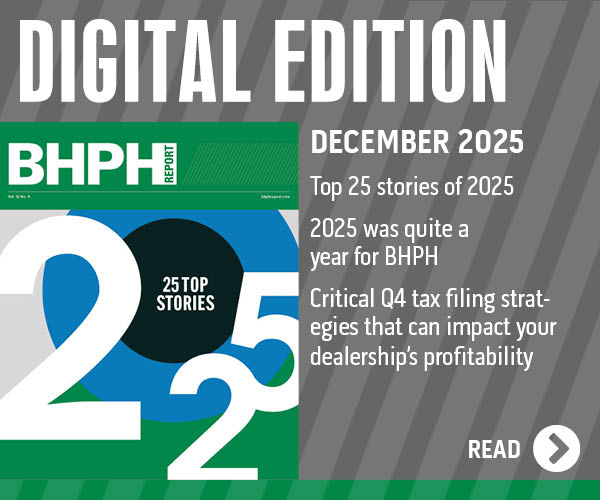4 questions with DealerSocket’s Peter Ord

By subscribing, you agree to receive communications from Auto Remarketing and our partners in accordance with our Privacy Policy. We may share your information with select partners and sponsors who may contact you about their products and services. You may unsubscribe at any time.
CARY, N.C. –
In the latest installment of the annual Best of BHPH issue of BHPH Report, we go behind the scenes with some of the leading companies in the used-car space and their top executives with a few Q&A features.
Next up in this series is Peter Ord, national sales director at DealerSocket.
BHPH Report: How much more critical is a functional DMS to an operator than it was even two or three years ago?
Peter Ord: Today, dealers are required to comply with more regulations than ever before — and this high-scrutiny environment isn’t going away. Some may not want to accept it, but this is the new normal. In light of that realization, DMS is core to the dealership and has become the central source for control of all dealer functions, from evaluation and acquisition of inventory all the way through to sales, collections and analytics. If dealers want to compete and comply in today’s market, they need a DMS.
Regulators like the CFPB aren’t discriminating based on the size of your dealership either. They regularly make examples of both big and small dealers. Enforcement is only becoming more stringent, necessitating documented, automated processes that an effective DMS can provide. Over and over, we observe that if regulators come into your store and see you’re still operating off pen, paper and unlocked filing cabinets, you may be in for a long ride. However, they are much less likely to dig deep into your business if you have defined processes and proven, automated systems in place.
My philosophy is, you just can’t take chances anymore — not when there are this many regulators going from dealer to dealer, looking to sue them for the benefit of the consumer. If you can prove that you make a solid effort though, you are much more likely to be pardoned for a small mistake. We frequently hear from these regulators that they look for dealers who have inadequate infrastructure to support their business, have systematic failures or act with blatant dishonesty.
Subscribe to Auto Remarketing to stay informed and stay ahead.
By subscribing, you agree to receive communications from Auto Remarketing and our partners in accordance with our Privacy Policy. We may share your information with select partners and sponsors who may contact you about their products and services. You may unsubscribe at any time.
I would also add that efficiently managing inventory is the life blood of today’s independent dealer, and that is another function a solid DMS can fulfill. Having a prime physical location is no longer the main indicator to success though. As a matter of fact, a dealer’s digital location (i.e., their website) has become more important than their physical store. So it stands to reason that dealers who invest in inventory syndication through their DMS can gain a clear advantage over those who are still running such processes by hand.
BHPH Report: What part of a DMS is still confusing or frustrating for a dealer and why?
Peter Ord: Hands down, I believe the user interface is most confusing. The majority of DMS options focus on features without taking the time to understand how those features should be presented to the user. We admittedly had these same issues with our legacy DMS technology. When we built iDMS, however, we spent a significant amount of time studying design, user interface and user experience. We even dedicated entire teams to each one of those concepts. As a result, many of our iDMS beta users thought we had created a slew of new features that had actually been available to them all along. They just could not benefit from them because they were either too hard to find or were not integrated into the correct workflow.
Along the same lines, many DMS options provide heaps of data, but much of it is not actionable. In order for the data to be helpful to dealers, the software must synthesize and present it in a way that dealers can truly use. In the same way, the processes that a DMS handles can be quite complex, and many DMS options on the market today struggle to address these processes with a streamlined, automated approach that reduces errors and saves time.
The bottom line is that any technology platform should be easy enough and serve up enough valuable information that it becomes impossible for the user not to use it. The intuitiveness of the system is ultimately what should convince an employee to use the software, not the threat of consequences from management.
BHPH Report: What three elements should dealers evaluate when considering which DMS to use?
Peter Ord: First, you should examine a system’s reporting and integration capabilities. I’m referring to real-time, web-based integration, not batch integrations that require more human touch and don’t stay up to date throughout the day. DMS technology with these characteristics enable dealers to do their jobs better, easier and faster. We know a DMS cannot solve all a dealer’s problems, but that’s exactly why it must integrate seamlessly with other products. Much of a DMS’ data is valuable and should translate easily into other software, so it can help dealers manage their customer base more effectively. You want tight integrations between your DMS and CRM so you can get, for example, filtered lists of customers that are nearing finance termination that have not been repo’d or just spent more than $500 in your service lane on a repair. That sort of targeting will prove especially useful when proactively reaching out to previous customers for repeat sales.
Second, you should look at whether a platform is web-based or client-based. Can you use your DMS on any device, anywhere? Seven to 10 years ago, people would have thought you were crazy for using a web-based solution. Now, you’re way behind if you’re still on a client-based platform. Web-based solutions offer more agile integration capabilities than web platforms. It’s extremely difficult to integrate with other products on a client-based system. Of course, users also cannot access the platform at a moment’s notice, optimized on their mobile device. I believe one of the aspects that separates the superior operators from the average is using current, live information to make decisions.
Lastly, a DMS in today’s market should offer a custom user experience based on role. It should focus on how each individual user needs to leverage the DMS and tailor the experience based on their needs. The accounting office, controllers, business owners, GMs, sales managers, inventory managers … they all use the DMS. Yet most DMS technology offers the same user experience to every user, regardless of role. Dealers should look for a DMS that allows you to customize the home screen — and really the entire experience — based on the features each user needs for his or her job. For example, if I’m an inventory manager, I don’t need to wade through functionality to desk deals or even see the collections module. I need to be able to efficiently add inventory, add pictures and descriptions, and post to third-party websites. Those functions should be front and center, easy to access, and simple to execute. I believe dealers are frustrated that it takes them way too long to do basic tasks in their DMS. But you can remove five or six clicks from any given task by using a DMS that allows customization by user role.
BHPH Report: What recent technological advancement has helped DMS function better?
Peter Ord: Cloud-based architecture is becoming more robust, with more enhanced, secure environments and more agile integration capabilities. Five years ago, the only way to integrate with another product was to send batch files in the form of an Excel spreadsheet. Today, we can take advantage of real-time web services to give the experience of using one system instead of two, or three or four. Open APIs help facilitate this data sharing, so information moves two ways instead of just one. None of these benefits are available with a client- or server-based platform.
In addition, user-based customized screens are a game changer. If I’m a collector, I want my workflows and home screen elements to focus only on what I need to do my job most efficiently. This allows for quicker, easier training and ramp-up of new employees. It also helps established employees leverage all the features available to them much faster.
I encourage every dealer to ask their potential DMS provider whether they employ dedicated user experience designers. Most don’t, and you won’t want a DMS with a user interface that has zero study or science behind it. If you have a fantastic feature set with a poor user experience, the features don’t even matter because no one can find them. That’s what leads to frustrating, crowded, and hard-to-use technology. I believe both the feature set and the user experience should be weighted equally.
Additional pieces from this series can be found below:
4 questions with Bill Caan, national sales manager at CalAmp
4 questions with NCM Associates’ Brent Carmichael
4 questions with Russ Algood of Ace Motor Acceptance


